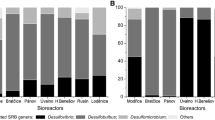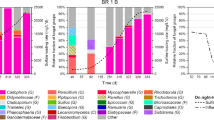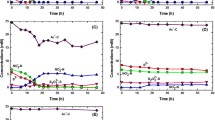Abstract
Eleven pure strains of sulfate-reducing bacteria have been isolated from lab-scale bioreactors or gypsum disposal sites, all featuring relatively high concentrations of sulfate, and from natural environments in order to produce sulfide from gypsum using hydrogen as energy source. The properties of the eleven strains have been investigated and compared to these of three collection strains i.e. Desulfovibrio desulfuricans and Dv. vulgaris and Desulfotomaculum orientis. Particular attention was paid to the volumetric and specific sulfide production rate and to the hydrogen sulfide inhibition level. By comparison to the three collection strains, a 75% higher production rate and a hydrogen sulfide inhibition level about twice as high i.e. 25.1 mM have been achieved with strains isolated from sulfate-rich environments. The strain selection, particularly from sulfate-rich environments, should be considered as an optimization factor for the sulfate reduction processes.
Similar content being viewed by others
Author information
Authors and Affiliations
Rights and permissions
About this article
Cite this article
Hiligsmann, S., Jacques, P. & Thonart, P. Isolation of highly performant sulfate reducers from sulfate-rich environments. Biodegradation 9, 285–292 (1998). https://doi.org/10.1023/A:1008382102417
Issue Date:
DOI: https://doi.org/10.1023/A:1008382102417




